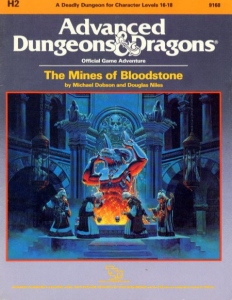
The Temple of Elemental Evil is an adventure module for the fantasy role-playing game Dungeons & Dragons, set in the game's World of Greyhawk campaign setting. The module was published by TSR, Inc. in 1985 for the first edition Advanced Dungeons & Dragons rules. It was written by Gary Gygax and Frank Mentzer, and is an expansion of an earlier Gygax module, The Village of Hommlet. The Temple of Elemental Evil is also the title of a related 2001 Thomas M. Reid novel and an Atari computer game.

Tomb of Horrors is an adventure module written by Gary Gygax for the Dungeons & Dragons (D&D) role-playing game. It was originally written for and used at the 1975 Origins 1 convention. Gygax designed the adventure both to challenge the skill of expert players in his own campaign and to test players who boasted of having mighty player characters able to best any challenge. The module, coded S1, was the first in the S-series, or special series of modules. Several versions of the adventure have been published, the first in 1978, and the most recent, for the fifth edition of D&D, in 2017 as one of the included adventures in Tales from the Yawning Portal. The module also served as the basis for a novel published in 2002.
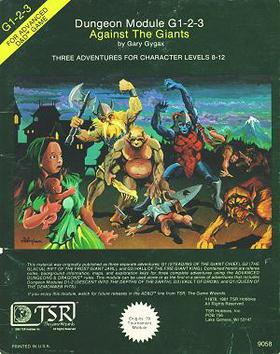
Against the Giants is an adventure module written by Gary Gygax and published by TSR in 1981 for the Dungeons & Dragons fantasy role-playing game. It combines the G series of modules previously published in 1978: Steading of the Hill Giant Chief, Glacial Rift of the Frost Giant Jarl, and Hall of the Fire Giant King. All three were produced for use with the 1st edition Advanced Dungeons & Dragons rules. In 1999, to recognize the 25th anniversary of TSR, the company released an updated version, Against the Giants: The Liberation of Geoff. Later in 1999, Wizards of the Coast published a novelization of Against the Giants by Ru Emerson.

H1 Bloodstone Pass is an adventure module for the first edition of the Advanced Dungeons & Dragons (D&D) fantasy role-playing game. It was written by Douglas Niles and Michael Dobson and published by TSR, Inc., in 1985. While it contained some traditional D&D elements, the main portion of the module was a series of mass battles using the D&D Battlesystem.

H3 - The Bloodstone Wars is an Official Game Adventure or "module" for Advanced Dungeons & Dragons.
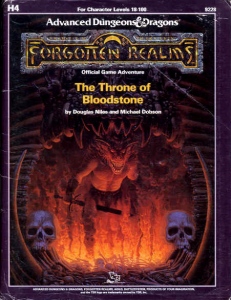
H4 - The Throne of Bloodstone is an Official Game Adventure or "module" for the Advanced Dungeons & Dragons fantasy role-playing game.

The Forgotten Temple of Tharizdun is an adventure module for the Dungeons & Dragons (D&D) role-playing game, for use in the World of Greyhawk campaign setting. The module was published by TSR, Inc. in 1982 for the first edition Advanced Dungeons & Dragons rules.

Mordenkainen's Fantastic Adventure by Robert J. Kuntz and Gary Gygax is an adventure module for the Dungeons & Dragons role-playing game, published by TSR, Inc. in 1984. It originally bore the code "WG5" and was intended for use with the Advanced Dungeons & Dragons first edition rules. Because it is one of the WG modules, it is a module intended for the World of Greyhawk campaign setting. It was later updated in 2004 to the Third Edition Revised rules in Dungeon magazine, issue #112, as Maure Castle. There were subsequently two additional installments in issues #124 and #139.

Dragons of Faith is the second of four parts in the third major story arc of the Dungeons & Dragons Dragonlance series of game modules. It is one of the 14 Dragonlance adventures published by TSR between 1984 and 1986. Its cover features a painting by Jeff Easley.
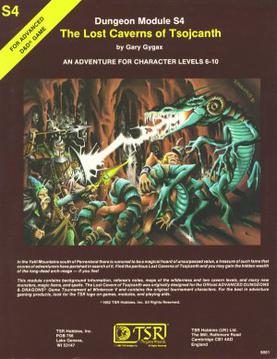
The Lost Caverns of Tsojcanth is an adventure module for the Dungeons & Dragons fantasy role-playing game. It was written by Gary Gygax and published by TSR in 1982 for the first edition Advanced Dungeons & Dragons (AD&D) rules. The 64-page adventure bears the code "S4" and is set in the Greyhawk campaign setting. It is divided into two parts, a 32-page adventure, and a 32-page booklet of monsters and magic items. The plot involves the player characters investigating rumors of lost treasure. After traversing a wilderness and two levels of dungeons, the players face Drelnza, the vampiric daughter of long-deceased archmage Iggwilv.
The DL series is a series of adventures and some supplementary material for the Advanced Dungeons & Dragons role playing game. These modules along with the Dragonlance Chronicles trilogy of novels, which follow one possible adventure series through the modules, were the first published items that established the Dragonlance fictional universe. The original DL series was released from 1984 to 1986, with the final two modules added to it in 1988. In the 1990s these roleplaying adventures from the original series were collected and revised for 2nd Edition AD&D as the three DLC Dragonlance Classics modules. There were also versions of the module series released in 1999, 2000 and 2006.

Dragons of Desolation is the fourth and final module in the first major story arc in the Dungeons & DragonsDragonlance series of game modules. It is one of the fourteen Dragonlance adventures published by TSR between 1984 and 1986. The module is intended for player characters of level 6–8.
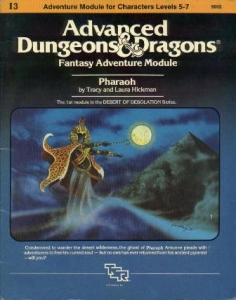
Desert of Desolation is a compilation adventure module published by TSR for the Dungeons & Dragons (D&D) fantasy roleplaying game. It combines three previously published individual modules: Pharaoh, Oasis of the White Palm, and Lost Tomb of Martek. The modules were made for use with the first edition Advanced Dungeons & Dragons (AD&D) rules. Pharaoh was created by Tracy and Laura Hickman soon after the couple married in 1977, and published by TSR in 1982. Oasis of the White Palm was a collaboration between Tracy Hickman and Philip Meyers, and Hickman wrote the Lost Tomb of Martek on his own; both were printed in 1983.

Night's Dark Terror is an adventure module for the Dungeons & Dragons (D&D) fantasy role-playing game written by British game designers Jim Bambra, Graeme Morris, and Phil Gallagher. It was designed specifically for campaigns transitioning from the D&D Basic Set to the D&D Expert Set. The player characters (PCs) journey from a farmstead into uncharted wilderness, where they encounter new hazards and contend with a secret society. The adventure received a positive review from White Dwarf magazine.

The Gauntlet is an adventure module for the Dungeons & Dragons fantasy role-playing game, set in the World of Greyhawk campaign setting.
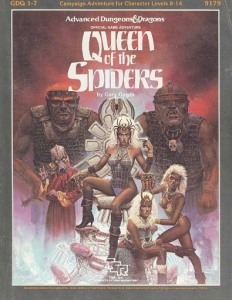
Queen of the Spiders is an adventure module for the Dungeons & Dragons fantasy role-playing game. It was published by TSR, Inc. in 1986 and is a compilation of seven previous related modules, often referred to as a "supermodule." Together, the seven adventures form an integrated campaign that begins in the World of Greyhawk, continues underground into the Underdark, and concludes in the Demonweb Pits, the abyssal lair of the demonic goddess Lolth. The campaign was originally intended for use with the rules from the first edition of Advanced Dungeons & Dragons.

Saga of the Shadow Lord is a 1986 adventure module for the Basic Rules of the Dungeons & Dragons fantasy role-playing game.
The Wand of Orcus is a fictional magical weapon described in various Dungeons & Dragons media. Because of the popularity of Orcus as a villain within the Dungeons & Dragons universe, many different authors have written materials describing artifacts created by or associated with the character. The Wand of Orcus is consistently the most important and most described of these artifacts. Screen Rant has noted that "[t]he weapon that Orcus wields in battle is almost as famous as the demon lord himself". Furthermore, the device has at times been employed in books, games, and other media within the franchise as a thing distinct from Orcus himself, such that adventurers may encounter the wand as a freestanding element of the game or story.

Keep on the Shadowfell is the first official product from the 4th edition Dungeons & Dragons ("D&D") line. It is part one of a three-part series of adventures. It introduces a series of 4th edition Dungeons & Dragons settings called the Points of Light, a loosely connected and open-ended series of settings designed to allow other modules and fan-created content to be integrated seamlessly into the settings' largely unmapped fantasy world or the Dungeon Master's own custom-made setting. The adventure, written by Mike Mearls and Bruce R. Cordell, was published in 2008 by Wizards of the Coast. It is followed by the sequels Thunderspire Labyrinth and Pyramid of Shadows. The adventure is designed for characters from levels 1 to 3. Its module code, "H", stands for Heroic Tier. This module is set in a region of the world called the Nentir Vale, which is described in greater detail in the 4th edition Dungeon Master's Guide.
